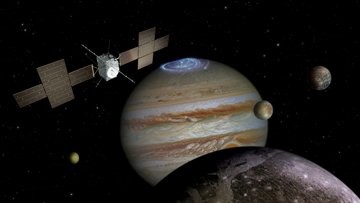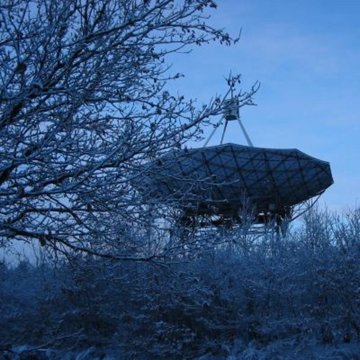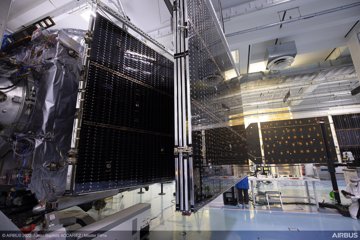To the moons of Jupiter with Dutch science and technology
The Jupiter Icy Moons Explorer (Juice) is one of the largest, one of the most expensive, one of the most ambitious planetary space missions Europe has ever undertaken. It will be launched on April 13 at 2:15 p.m. our time. It will be an exciting day for Dutch engineers and scientists, as they are involved with innovative hardware as well as groundbreaking scientific experiments.

Juice at the Jiovian system (image: ESA)
Why do we want to go to Jupiter's moons? 'Because there is a lot we don't know yet,' says Bert Vermeersen, professor of Planetary Exploration at TU Delft and co-investigator of one of Juice's instruments. 'Beneath the ice on the Jupiter moons are large oceans of liquid salt water. What do those oceans look like? How thick is the ice? Do Jupiter's moons say anything about the moons of exoplanets? And is life possible on one of Jupiter's moons? Juice allows us to search for the answers for the first time.'
Juice is not the first space mission to visit Jupiter. In the 1970s, Voyagers flew past the giant planet. In the 1990s, NASA sent the Galileo space probe. But Juice is of an entirely different order, says Vermeersen: "Previous missions can be seen as an initial introduction. With Juice we are going to do real science. This mission will yield an enormous amount of data about the situation on Europa and Ganymede, among others. And that in turn is important for future missions, which may be landing on the ice and drilling for the ocean below.'
PRIDE from Holland
On board Juice are eleven experiments, including GALA and RIME. Laser altimeter GALA is going to map the topography of ice moons incredibly accurately, investigating tectonic activity and tidal movements. The RIME radar instrument can survey the ice of the moons up to nine kilometers deep. But both instruments work really well only if Juice's position is determined very accurately. And for that, the Dutch PRIDE experiment is of great importance.

Radiotelescoop in Dwingeloo (image: JIVE)
Dominic Dirkx, associate professor of Space Engineering at TU Delft, is working with JIVE in Dwingeloo on PRIDE. A unique experiment because it does not add mass to the satellite. It uses only the instruments already on board and a worldwide network of radio telescopes on Earth. Together, these telescopes determine super-precise where the space probe is and how fast it is flying through space. Dirkx: "With an observation of one minute, we can see changes of one millimeter in Juice's flight path. And we determine the location of the spacecraft to the nearest hundred millionth of a degree. That's comparable to finding a radio transmitter on the moon with no more than a five-centimeter margin.'
Dutch energy
Once PRIDE precisely determines Juice's location and velocity, and the instruments on board work properly, the scientific data will pour in. Answers to questions such as: what does the interior of the Jupiter moon look like? How did this interior evolve? What are the conditions in the oceans beneath the ice? And what is happening below the surface? The data flows in, when solar panels developed in the Netherlands generate enough energy to transmit this data to Earth.
It took Airbus Netherlands six years of planning and then another six years to actually produce the solar panels for the Juice mission. According to Rob van Hassel, product portfolio manager at Airbus Netherlands, 23,560 special solar cells are involved, distributed over two wings with a total area of 85 square meters and a power of 700 watts - just enough to heat up a meal in the microwave.

Deplyment test solar arrays Juice (image: ESA / Airbus)
'The special nature of this mission presented the necessary challenges,' says Van Hassel. 'The panels have to withstand temperatures from +250 degrees as Juice flies past Venus to -237 degrees at Jupiter. They have to withstand twenty times more radiation than Earth-observing satellites close to Earth. And they must withstand eighty to one hundred times the gravity caused by vibrations during launch.'
With their typical cross shape, intended to reduce wing span, the solar panels are one of a kind. Or are they? Van Hassel: 'Yes, it's all custom-made. But with this assignment for the Juice mission, we also put ourselves in the spotlight with NASA. Now we are developing the solar panels for the American Europa Clipper mission. So a Dutch investment in Juice results in great science, but also follow-up contracts. Which is very important for a company like Airbus.
Most advanced
Christian Erd and Alessandro Atzei, respectively Spacecraft & System Manager and Payload System Engineer at ESTEC in Noordwijk, are also looking forward to the launch of Juice. The probe is the first of three "largest class" missions in ESA's Cosmic Vision program. Juice is 4.5 meters tall and weighs 6,100 kilograms including 3,700 kilograms of propellant. Daily, Juice sends two terabytes of data to Earth, collected by eleven instruments, including the 16-meter-long RIME antenna that can 'see' beneath the surface of ice moons. 'This is the largest, most advanced set of instruments ever sent to Jupiter,' the ESA staff proudly concluded.
Why the Netherlands is participating in this major undertaking? Joost Carpay, deputy director of the NSO and representative on behalf of the Netherlands on ESA's Scientific Program Council (SPC), can be brief about that: 'The Netherlands is participating because we are members of ESA, but it goes beyond that. This mission provides scientists with important new information about our own solar system and about life in the universe. And enables the Netherlands to develop new, groundbreaking space technology.'